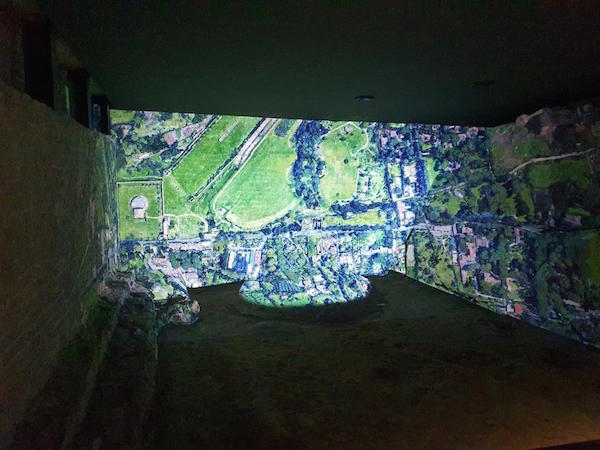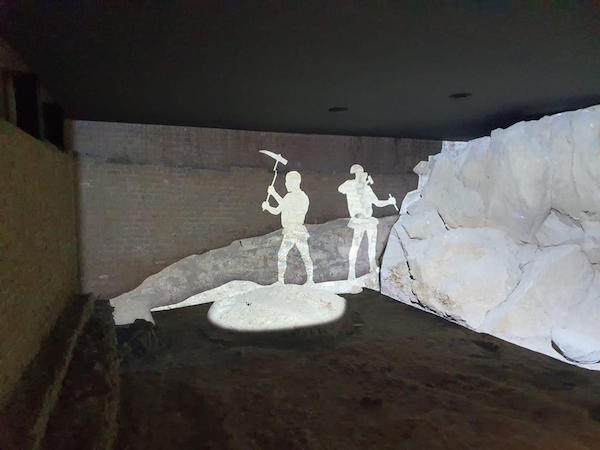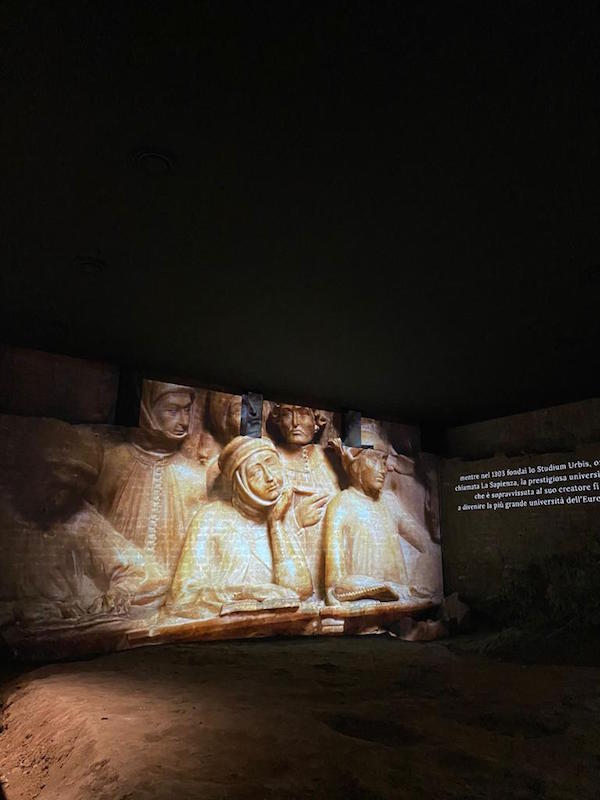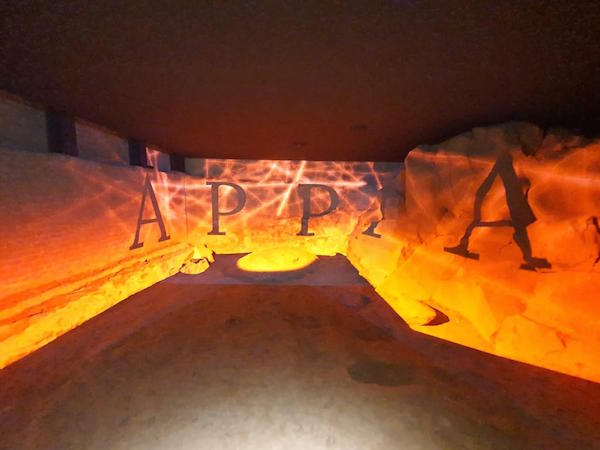Multimedia itineraries at the Mausoleum of Cecilia Metella I Courtesy of the Appia Antica Archaeological Park
“The project aims to make the archaeological sites of the Appia Antica Park increasingly accessible, using technologies to offer the widest possible public the full understanding and usability of the monuments”, he explains the director of the Park Simone Quilici. “With this same objective a few months ago we inaugurated a multimedia intervention in Santa Maria Nova, the farmhouse located next to the Villa dei Quintili and which will host the exhibition until 30 June Patrimonium Appiae. Thanks to video mapping, visitors can retrace the history of the Villa and the surrounding landscape from antiquity to the present day”.
Together with the medieval Castrum Caetani, the Mausoleum of Cecilia Metella forms a single, extremely interesting archaeological complex… How will the new installations help us to get to know and appreciate it?
“The Mausoleum of Cecilia Metella is probably the most recognizable monument, the icon of the Park. It can be appreciated in all its grandeur from the street but, once inside, a great effort of the imagination was needed to project oneself into its past. From today we are able to offer the public a completely different experience, thanks to three speeches that take a total of three quarters of an hour. Each visitor will be free to follow the complete itinerary, or to choose a part of it, or even to approach the monument in the traditional way. Overall, the new itinerary provides a spectacular overview of the history of the Castrum and the Mausoleum, retracing their events accurately over a wide period of time”.

Multimedia itineraries at the Mausoleum of Cecilia Metella I Courtesy of the Appia Antica Archaeological Park
The story begins already in prehistoric times, long before the arrival of the Romans…
“The first intervention is located in the Sala Lava, a suggestive underground environment where the Capo di Bove lava flow emerges, which starts from the Castelli Romani and stops in the Mausoleum area, characterizing the geology of the Appia Antica Park. Here a videomapping tells the evolution of the territory and the landscape since the last eruption of the Lazio Volcano (the current Colli Albani ed), which took place about 300,000 years ago, until 312 BC, when the Romans began to build the Regina Viarum straight as a sword. But that’s not all: the narrative leads up to the fourteenth century, when Pope Boniface VIII undertook the construction of the castle, the Castrum Caetani. Like an apparition, the figure of the pontiff will materialize in front of the public to narrate the dream at the origin of his project. A member of the noble Caetani family, Bonifacio had the castle built to guard the countryside south of the city, as a bastion that symbolized the dominion of the Caetanis over Rome”.
With the Castrum Caetani and the Mausoleum of Cecilia Metella we enter the heart of the history of the site…
“The one at Castrum Caetani is the most sophisticated intervention, it has a truly impressive work behind it. Seated comfortably inside the castle, thanks to a 3D oculus, visitors will be able to retrace the construction and transformations of the building over time. Today only the perimeter walls remain of the important Castrum Caetani. A ten-minute video will restore the monument as it was in the times of Boniface VIIII: we will be able to walk through its spaces from the ground floor, with the warehouses, up to the large reception rooms on the main floors. The interiors with the relative furnishings have been reconstructed philologically with great care, in a very advanced product also on a visual level”.

Multimedia itineraries at the Mausoleum of Cecilia Metella I Courtesy of the Appia Antica Archaeological Park
“The third intervention”, continues Quilici, “is dedicated to the Mausoleum of Cecilia Metella, a testimony of republican Rome that dates back to the first century BC: thanks to a game of projections, inside the tomb the public will meet the Roman noblewoman, who he will tell the story of his family and of the monument”.
What other projects do you have in the pipeline to enhance the immense heritage of the Park?
“Together with the National Roman Museum, we are beneficiaries of the project Urbs. From the city to the Roman countryside with funds of 110 million euros. Our 30 million are intended for the restoration of all the sites of the Park, from the single monument such as the Mausoleum of Cecilia Metella to the large archaeological areas such as the Villa dei Quintili or the Villa di Sette Bassi, recently opened to the public after years of waiting. The sites will be affected by archaeological investigations and enhancement programs that will make them more usable and understandable by a vast public. Since these are interventions linked to the PNRR, the works will be completed by 2026″.

Multimedia itineraries at the Mausoleum of Cecilia Metella I Courtesy of the Appia Antica Archaeological Park
At what stage is the Appia Antica candidacy for Unesco World Heritage?
“In recent months, the work coordinated by the General Secretariat of the Ministry of Culture has intensified and will lead to the formalization of the candidacy at the beginning of 2023, with the presentation of the dossier and the management plan. The checks by the Unesco inspectors should probably take place next autumn, to conclude the entire process at the beginning of 2024. I cross my fingers and I am confident, given the high scientific value of the work carried out and given the value of the site concerned” .
“The candidacy – continues the director – concerns the entire route of the Appian Way from Rome to Brindisi, therefore four regions and over 70 municipalities, on a serial-type site for which the best preserved places have been selected, naturally including the of Rome and the Castelli Romani. This is the first candidacy of a road from Ancient Rome: the chances that the Regina Viarum will be included in the Unesco list are quite high”.
The Appia Antica extends from Rome to Brindisi along a route of approximately 500 kilometres. Are you already working to enhance the Regina Viarum as a whole?
“The theme of the Appian Way is connected to the UNESCO candidacy, brought to the fore by Paolo Rumiz, who in 2015 walked the entire route and recounted his experience in a book. For our part, together with the Ministry we are working to secure the extra-urban section between Rome and Marino, making it usable for walkers, cyclists and people on horseback. Not falling within the competence of the Superintendency of Rome, until recently this part of the Appia Antica remained completely abandoned to itself: it had become a jungle. The project involves the land reclamation, the removal of weeds, the restoration of the monuments and the restoration of the lateral sidewalks of the Roman road. When we have finished, walk on foot without interruption from Rome to Frattocchie, a fraction of the Municipality of Marino in the Castelli Romani, covering about 17 kilometres. It’s definitely a good start.”

Multimedia itineraries at the Mausoleum of Cecilia Metella I Courtesy of the Appia Antica Archaeological Park
Read also:
• The relaunch of the Appia Antica in Rome begins. Simone Quilici talks about it

